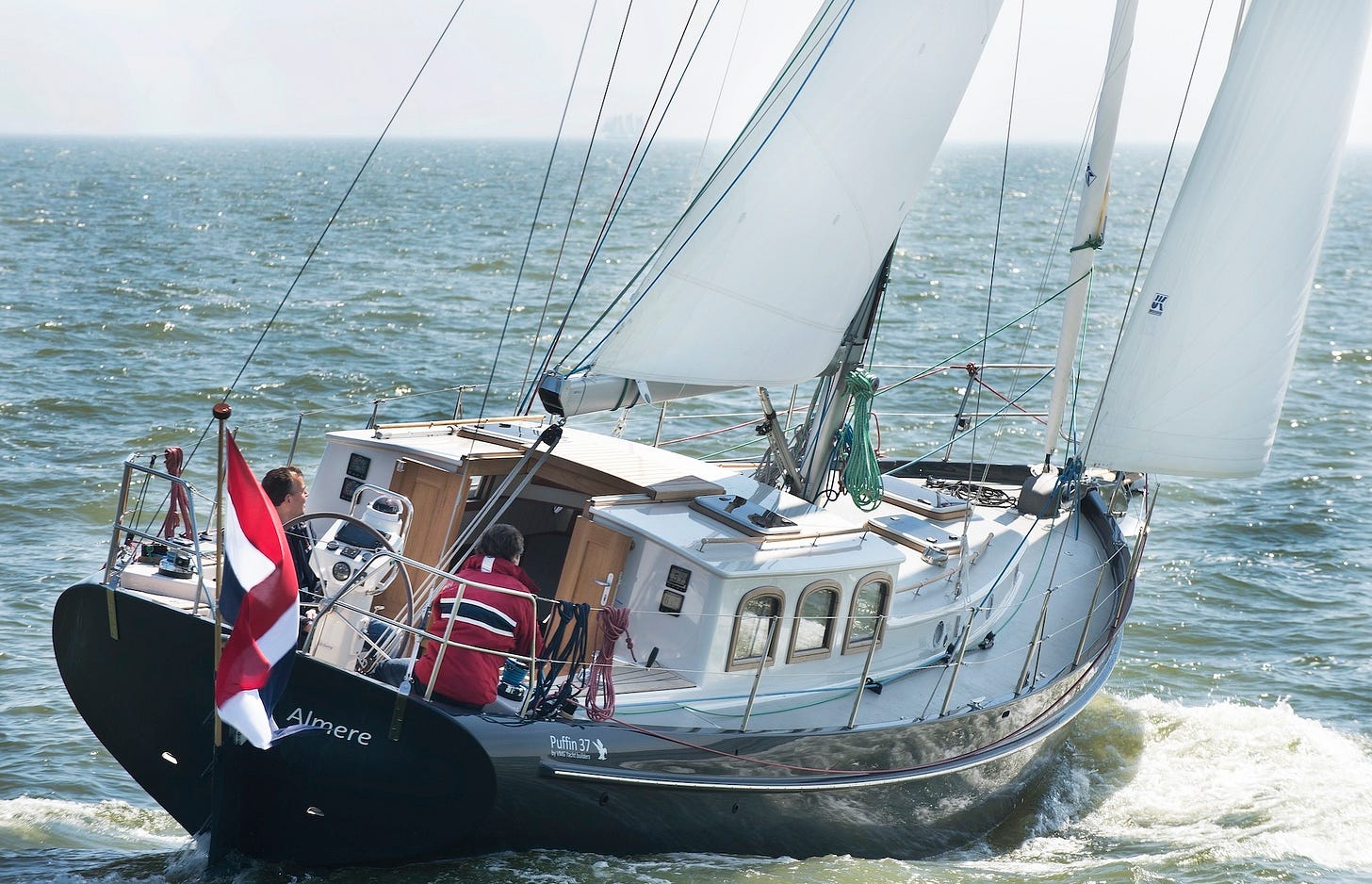The Case for Electric Auxiliary Propulsion in Sailing Yachts
ELECTRIC GREEN OFTEN MISSES THE MARK FOR ENERGY CONSERVATION, BUT NOT WHEN IT COMES TO AUXILIARY POWER FOR SAILING VESSELS

Notwithstanding a host of important open questions yet to be resolved, EVs and Hybrids continue to dominate the conversation concerning energy conservation going forward — especially when it comes to yachts. And yes, I’ve personally questioned whether electric propulsion really makes energy sense when you get down to answering some of those critical questions and paying attention to the physical facts of converting, storing, and re-converting electrical energy for self-propelled vehicles.
Lately, however, having recently spent time researching “solar generators” (power generation systems composed of solar panels for generating electrical energy and batteries to store that energy until it’s required), I’ve begun to think that electrical power might, in fact, be the ideal power choice for auxiliary propulsion in certain types of sailing yachts. Here’s why.
In order to understand this issue fully, one needs to start with the right perspective. Historically, “auxiliary propulsion” was for decades, if not centuries, just that — auxiliary. If there was wind, you sailed. And you reserved auxiliary propulsion to times when there wasn’t enough wind to provide steerage. Drifting is not generally a preferred mode of operation in floating craft. Except, perhaps, for river rafts, or when a harbor or anchorage is sufficiently congested to make movement under sail iffy and difficult or downright dangerous.
Again historically, sailing vessels moved under sail, and when the wind was insufficient in strength, they either just waited for the wind to pick up or anchored (if they could), and waited. When push really came to shove, they broke out auxiliary power in the form of manpower attached to long oars.
Seriously, in the 50s, 60s, and 70s, there we plenty of cruising sailors who plied the oceans with engineless boats. For example, Lin and Larry Pardey in their Bristol Channel cutter, Seraffyn. When they needed to move without wind into or out of harbor, they used a 14’ sweep to scull her into and out of marina slips. Or they used their tender and an anchor to kedge her into or out of tight quarters.
Admittedly, Seraffyn, was only 24’ LOA, but she was certainly not a lightweight. Later when they changed out Seraffyn for the 30’ Taleisin, the Pardeys again opted to sail engineless — although they did add a tender powered by a small outboard and lashed to her quarter for towing when they needed to move into and out of really tight spaces.
Before the Pardeys, there were Eric and Susan Hiscock, who girdled the globe in Wanderer III, a 30’ Laurent Giles sloop that was fitted with an 8-HP Stuart Turner two-stroke diesel engine. At a ratio of 1-HP per (long) ton displacement, this tiny auxiliary engine was used only for entering and leaving harbors and charging batteries — although occasionally it was likely used, as well, to hunt for breezes when the winds fell to flat calm or when an anchorage or harbor was within sight and the wind faltered.
Keep in mind that was when auxiliary engines were considered just that, auxiliary — and not expected to be used for driving a heavy hull upwind in difficult seas. In those days, horsepower selection ranged from about 1 bhp to 3 bhp per ton of displacement. Which is considered seriously low by common standards today. Yet I can tell you from seven-plus years experience in my own 40’ heavy-displacement pilothouse cutter that you can do a lot with as little as 2-1/2 bhp per ton displacement, provided you have a gearbox with a sufficiently high reduction ratio and a carefully chosen and load-matched three-blade propeller.
My first Noka was a short-ended pilothouse cutter, about 33’ on her LWL, and displaced about 15 long tons. She was fitted with a Westerbeke 4-107 diesel auxiliary engine, which was rated at 37 bhp @ 2300 rpm and drove a 20” three-bladed propeller with a 1.3 pitch ratio through a Hurth 2.5:1 reduction gear. In a flat calm, that auxiliary set-up easily pushed the Noka at hull speed — with enough torque at the prop to keep her moving respectably to windward in a substantial blow and seaway.
And she also passed what is considered, in my local part of the world, the acid test, namely, being able to make reasonable headway against the tidal current under the old 17th Street Causeway Bridge in Fort Lauderdale — which could, at times, exceed three knots in that restricted narrow channel.
Granted, most sailors these days want more powerful auxiliary engines. And many rely on motorsailing when the apparent wind pulls forward of a close reach. But my point is that big horses are not absolutely essential, provided you understand the full extent of what you can get out of an engine with less horsepower, when you engineer the drive train properly.
And what does that buy you? A lot — not the least of which is the ability to change over to all-electric auxiliary propulsion using energy supplied entirely by solar generation, particularly in tropical and sub-tropical waters.
Think of it: No gasoline or diesel fuel to carry (assuming you also use an electric outboard to power your tender). No smell or volatile fumes. Less weight in machinery and consumable fuel. A significant recovery of interior volume for improved stowage. And most likely greater reliability and better longevity (again assuming a well-engineered and properly installed system).
Ten or maybe even just five years ago, putting together such an all-electric auxiliary propulsion system for a small sailing yacht — say, 25 to 40 feet LOA — would not have been easy because the supply of readily-available off-the-shelf components was limited. Today, however, pretty much everything you might need can be purchased retail over “parts counters” or via mail order. Indeed, much of what would be needed is actually available in “kit” form with pre-matched components, for example, a solar generator with matched solar panels, controllers, and connectivity components.
Join Us in a FYBBO Exploratory Project
The idea makes so much sense — at least to us — that at For Yacht Builders, Buyers, and Owners, we’re starting to investigate further the real-world practicalities of putting together just such an all-electric propulsion package — from design and engineering to component specification and sourcing, fabrication, installation, and testing.
If you’d like to follow the exploration project as it evolves — or perhaps become part of the team that carries it forward, sign up for a premium level subscription and register your interest in either a) the relevant Chat thread or b) the relevant comment thread of our premium-level DIY Q&A section. If you do that, you’ll have the opportunity to join and help shape the ongoing conversation, and you will additionally be privy to the development process all along the way. You’ll also receive proprietary copies of any plans and specs developed, including the final BOM for a planned system, as well as the final project test results (assuming we get that far).
I look forward to continuing the conversation with you on the “inside”.
— Phil Friedman
Sponsored Afterword: If you’re ready to take a serious look at electrical propulsion, consider also bolstering your knowledge base with some master-class rated instruction from an acknowledged industry expert:
This BoatHowTo self-paced video course bundle comprises both "Boat Electrics 101" and "Advanced Marine Electrics", and includes video modules on solar energy generation and electrical propulsion.
These top-rated ABYC and ISO compliant courses are created and taught by industry experts, Nigel Calder and Dr. Jan Athenstädt. Check ‘em out…
© 2025 by Phil Friedman and Port Royal Marketing LLC — All Rights Reserved








Thanks Phil. I would be interested in helping with this project further ? Shall I message you directly? Cheers Neil
Great article Phil! Always cover the perspectives! And the realities. J